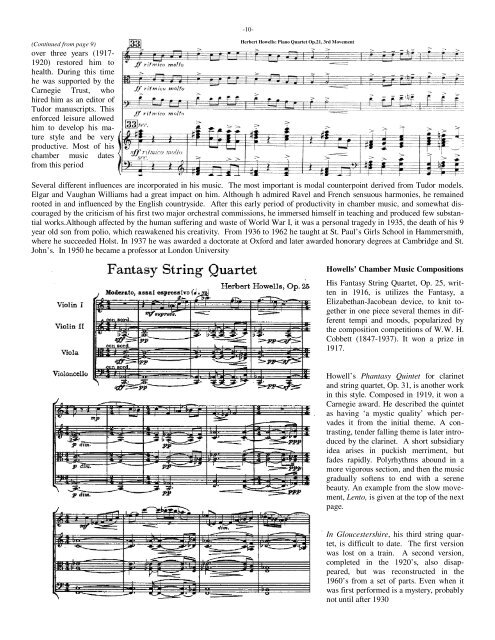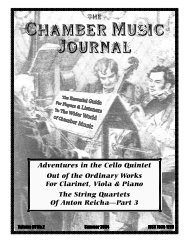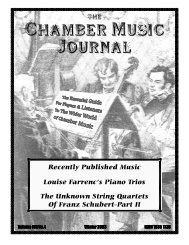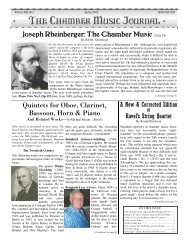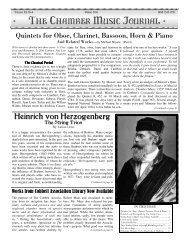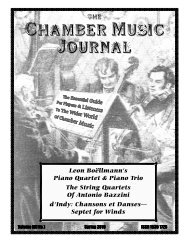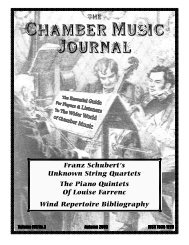Chamber Music Journal - Cobbettassociation.org
Chamber Music Journal - Cobbettassociation.org
Chamber Music Journal - Cobbettassociation.org
Create successful ePaper yourself
Turn your PDF publications into a flip-book with our unique Google optimized e-Paper software.
-10-<br />
(Continued from page 9)<br />
over three years (1917-<br />
1920) restored him to<br />
health. During this time<br />
he was supported by the<br />
Carnegie Trust, who<br />
hired him as an editor of<br />
Tudor manuscripts. This<br />
enforced leisure allowed<br />
him to develop his mature<br />
style and be very<br />
productive. Most of his<br />
chamber music dates<br />
from this period<br />
Herbert Howells: Piano Quartet Op.21, 3rd Movement<br />
Several different influences are incorporated in his music. The most important is modal counterpoint derived from Tudor models.<br />
Elgar and Vaughan Williams had a great impact on him. Although h admired Ravel and French sensuous harmonies, he remained<br />
rooted in and influenced by the English countryside. After this early period of productivity in chamber music, and somewhat discouraged<br />
by the criticism of his first two major orchestral commissions, he immersed himself in teaching and produced few substantial<br />
works.Although affected by the human suffering and waste of World War I, it was a personal tragedy in 1935, the death of his 9<br />
year old son from polio, which reawakened his creativity. From 1936 to 1962 he taught at St. Paul’s Girls School in Hammersmith,<br />
where he succeeded Holst. In 1937 he was awarded a doctorate at Oxford and later awarded honorary degrees at Cambridge and St.<br />
John’s. In 1950 he became a professor at London University<br />
Howells’ <strong>Chamber</strong> <strong>Music</strong> Compositions<br />
His Fantasy String Quartet, Op. 25, written<br />
in 1916, is utilizes the Fantasy, a<br />
Elizabethan-Jacobean device, to knit together<br />
in one piece several themes in different<br />
tempi and moods, popularized by<br />
the composition competitions of W.W. H.<br />
Cobbett (1847-1937). It won a prize in<br />
1917.<br />
Howell’s Phantasy Quintet for clarinet<br />
and string quartet, Op. 31, is another work<br />
in this style. Composed in 1919, it won a<br />
Carnegie award. He described the quintet<br />
as having ‘a mystic quality’ which pervades<br />
it from the initial theme. A contrasting,<br />
tender falling theme is later introduced<br />
by the clarinet. A short subsidiary<br />
idea arises in puckish merriment, but<br />
fades rapidly. Polyrhythms abound in a<br />
more vigorous section, and then the music<br />
gradually softens to end with a serene<br />
beauty. An example from the slow movement,<br />
Lento, is given at the top of the next<br />
page.<br />
In Gloucestershire, his third string quartet,<br />
is difficult to date. The first version<br />
was lost on a train. A second version,<br />
completed in the 1920’s, also disappeared,<br />
but was reconstructed in the<br />
1960’s from a set of parts. Even when it<br />
was first performed is a mystery, probably<br />
not until after 1930


